A long time ago, in a faraway place, there was a big fair. Lots of people came, even kings and queens from all over! One king brought his daughter with him. Near their tent, another king’s son had his tent. He was very handsome, and the king’s daughter was very pretty too!
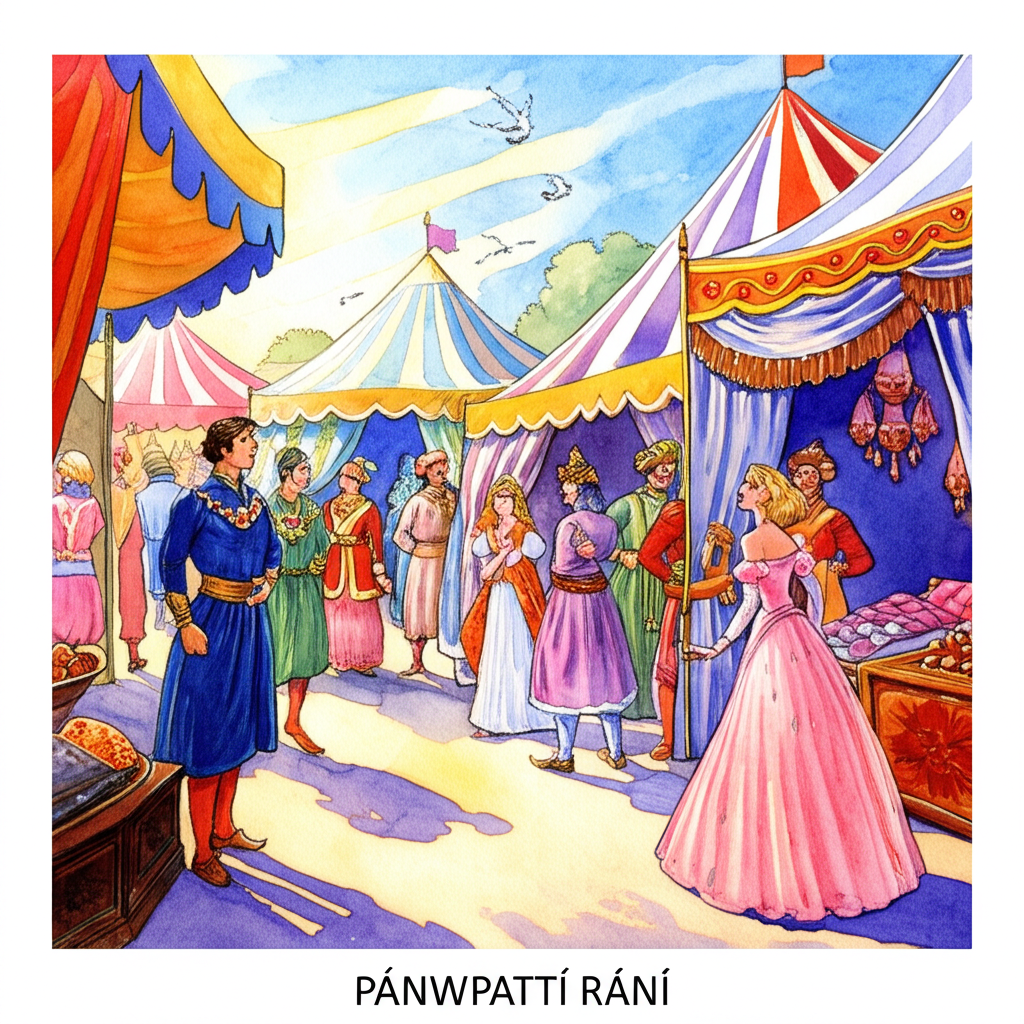
Now, the prince and the princess didn’t know each other’s names. But they looked at each other a lot, and they both thought the other was super beautiful. “Wow, she’s pretty!” thought the prince. “He’s so handsome!” thought the princess.
They stayed near each other for a whole month. They never talked or even said anything about each other. But they thought about each other all the time.
When the month was over, the princess’s dad said they had to go home. The prince sat in his tent and watched the helpers getting the princess’s special chair ready. When the princess was all dressed and ready to go, she came out of her tent with a rose. First, she touched the rose to her teeth, then she put it behind her ear, and last, she dropped it on the ground. The prince watched her the whole time. Then, she got into her chair and was carried away.
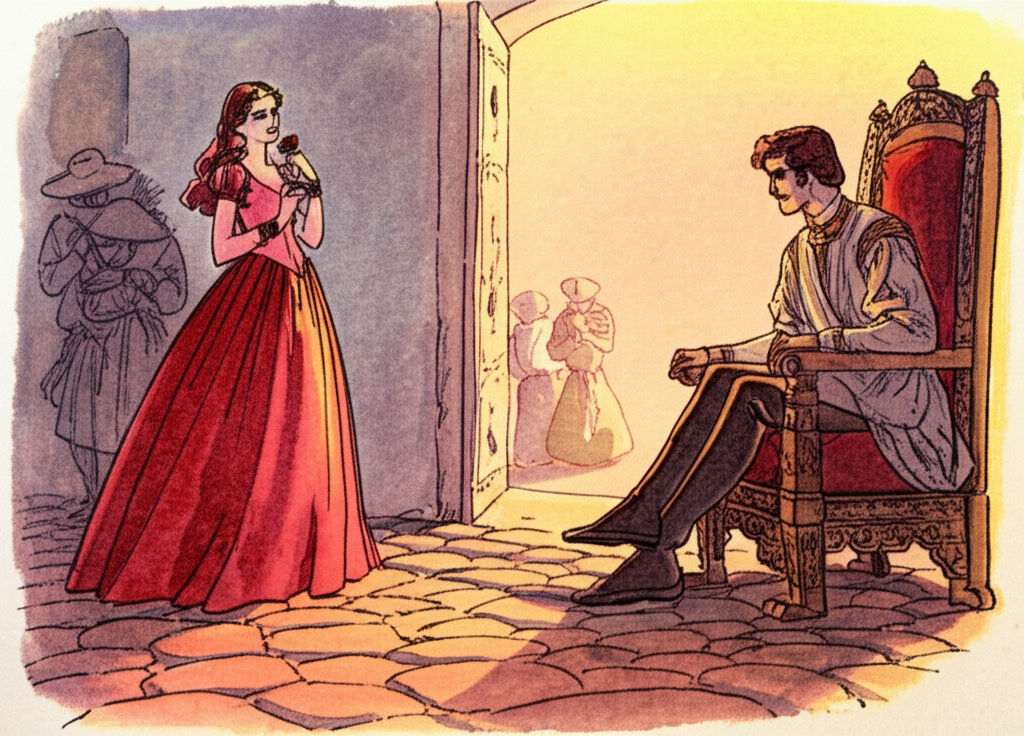
The prince was super sad now. “She’s so lovely!” he thought. “But I don’t know her name, her dad’s name, or where she lives! How will I ever find her again? I’ll never see her!” He was so sad that he decided to go home. When he got there, he went to bed and stayed there, day and night. He wouldn’t eat, drink, wash, or even change his clothes! His mom and dad were very worried. They asked him, “What’s wrong? Are you sick?” But he just said, “I don’t want anything. I don’t need a doctor or medicine.” He didn’t tell them about the beautiful princess.
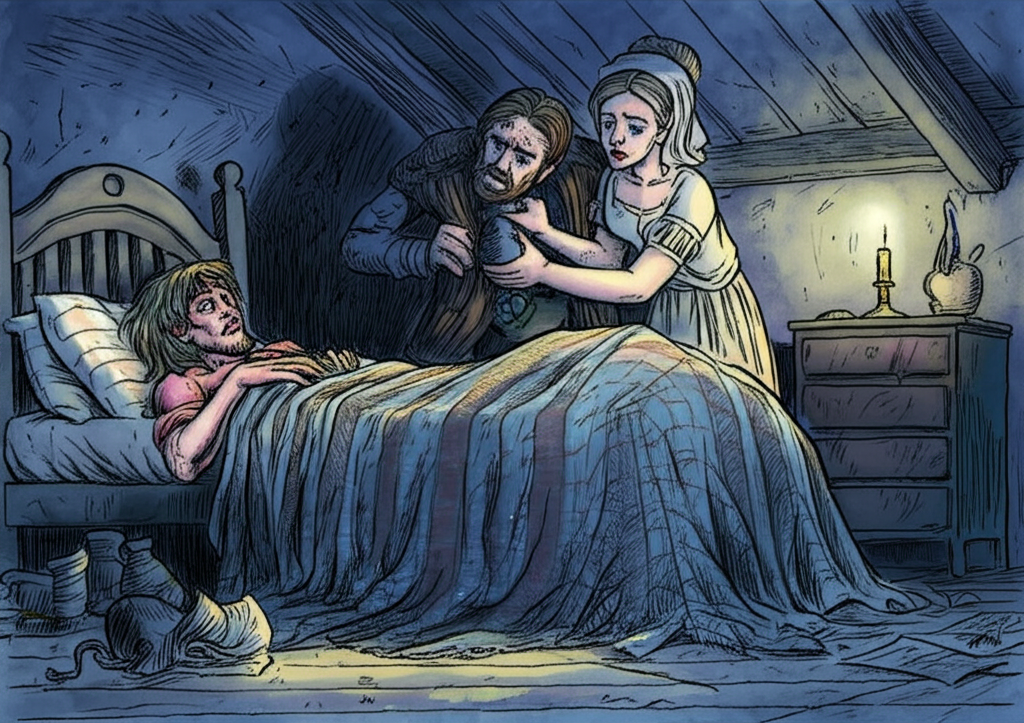
The prince’s best friend was the son of the head of the police. They had always gone to school together, read the same books, and played together. After the prince had been home for two days and hadn’t gone to school, his friend got worried. “Why isn’t the prince coming to school?” he thought. “He’s been home for two days and I haven’t seen him. I’ll go check on him. Maybe he’s sick.”
So he went to see the prince, who was lying in bed feeling very sad. “Why aren’t you at school? Are you sick?” asked his friend. “Oh, it’s nothing,” said the prince. “Tell me what’s wrong!” said his friend, but the prince wouldn’t answer. “Have you told anyone what’s wrong?” asked his friend. “No,” said the prince. “Then tell me! Tell me the truth! What’s bothering you?”
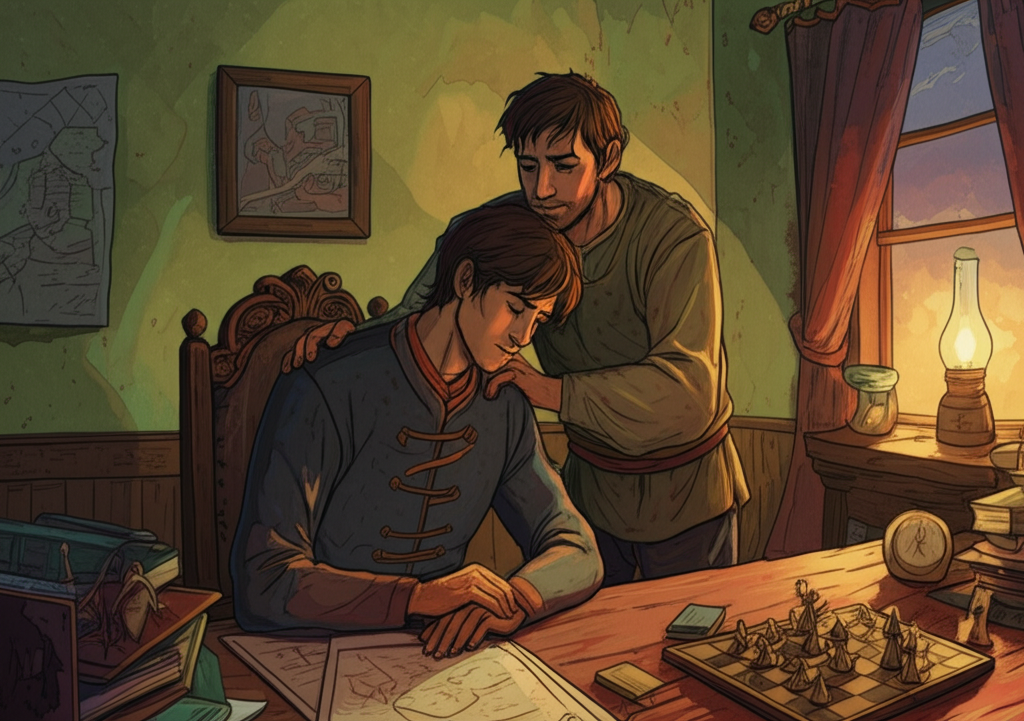
“Okay,” said the prince. “At the fair, there was a king with a very beautiful daughter. They lived in a tent across from mine, and I saw her every day. She’s so pretty! But I don’t know her name, her dad’s name, or where she lives. How can I ever find her?” “I’ll take you to her!” said his friend. “Just get up, take a bath, and eat something.” “How can you take me to her?” said the prince. “You don’t even know where she is!” “Did she ever talk to you?” asked his friend. “Never,” said the prince. “But when she was leaving, before she got into her chair, she took a rose. First, she touched it to her teeth, then she put it behind her ear, and then she dropped it on the ground.” “Now I know everything!” said his friend. “When she touched the rose to her teeth, she was telling you her dad’s name was King Tooth! When she put it behind her ear, she was telling you her home was called Ear Land! And when she dropped it on the ground, she was telling you her name was Foot Leaf! Get up, wash up, get dressed, eat and drink, and we’ll go find her!”
The prince jumped out of bed and told his mom and dad he was going on a trip to get some fresh air. At first, they said no, but then they thought he had been sick, and maybe fresh air would make him feel better. So, they let him go. The prince and his friend got two horses ready and rode off together.
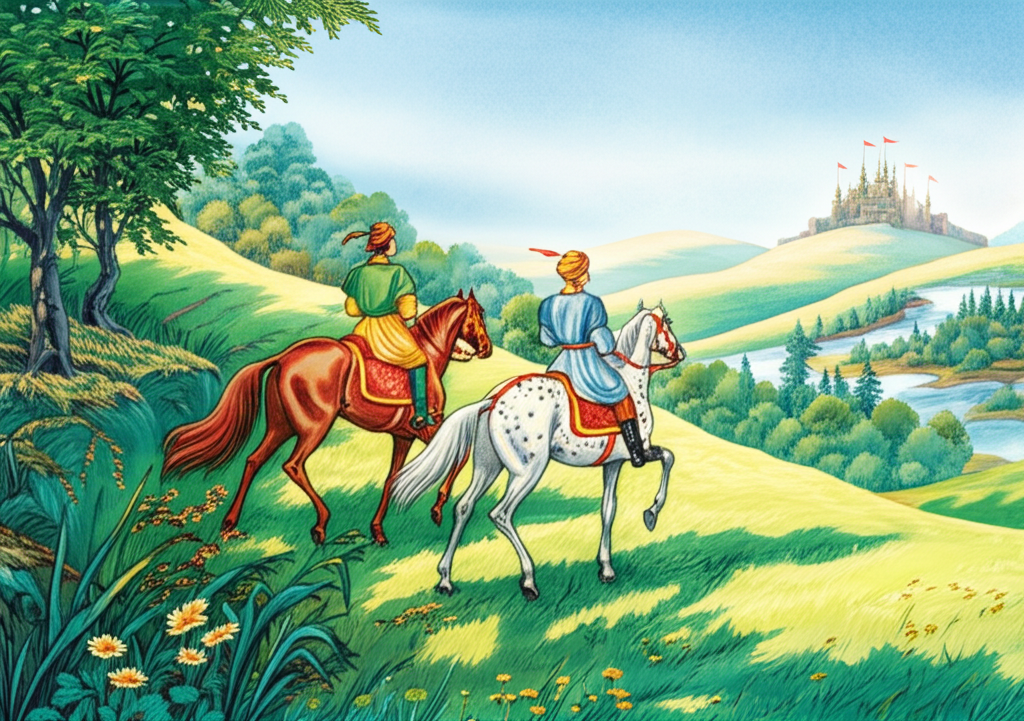
After a month, they got to a place where they asked (like they had asked in every place they rode through), “What is this place called?” “Ear Land!” “What is your king’s name?” “King Tooth!” The two friends were so happy! They stopped at an old woman’s house and said, “Can we stay with you for a few days? We’re from another country and don’t know where to go.” The old woman said, “You can stay if you want. I live alone, and there’s lots of room.”
After a few days, the prince’s friend asked the old woman, “Does your king have a daughter?” “Yes,” she said. “He has a daughter named Princess Foot Leaf.” “Can you go see her?” asked the friend. “Yes,” she said. “I was her babysitter, and she drank my milk. The king gives me my house, food, clothes—everything I have.” “Then go see her,” said the friend, “and tell her that the prince she saw at the fair is here!”
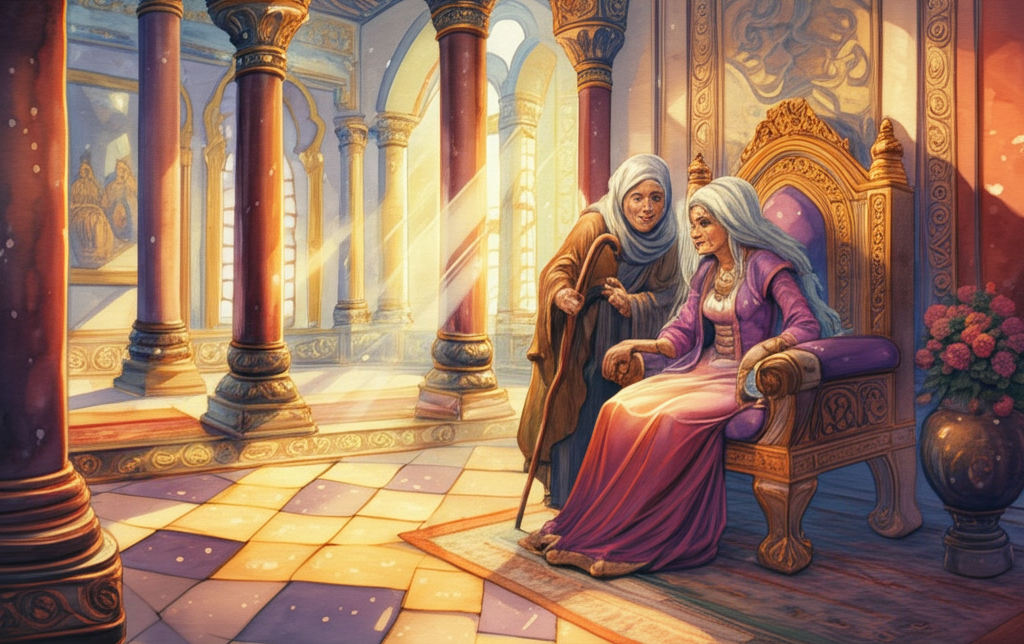
The old woman went to the palace and saw the princess. After they talked for a while, she said, “The prince you saw at the fair is here!” “Good!” said the princess. “Tell him to come see me tonight at twelve o’clock. But don’t come through the door, come through the window!” (She said this because she didn’t want her dad to know the prince was there until she decided if she wanted to marry him.)
The old woman went home and told the prince’s friend what the princess said. That night, the prince went to see her, and he went every night for a few nights to talk with her. Then, she told her mom she wanted to get married, and her mom told her dad. Her dad asked who she wanted to marry, and she said, “The prince who lives in my babysitter’s house!” Her dad said she could marry him if she wanted, so they had a wedding! The prince’s friend went to the wedding and then went back to the old woman’s house. But the prince stayed in the king’s palace.
He stayed there for a month, and he never saw his friend. Finally, he missed him a lot and was very sad. “What’s making you so sad?” asked Princess Foot Leaf. “I’m sad because I haven’t seen my friend for a whole month,” said her husband. “I have to go see him.” “Yes, go see him,” said his wife. The prince went to the old woman’s house and stayed there for a week because he was so happy to see his friend. Then he went back to his wife. She thought he had only been gone for a day and was very mad that he had stayed away so long. “How could you leave me for a whole week?” she said. “I hadn’t seen my friend for a month,” he said. The princess didn’t let her husband see how angry she was, but she thought, “I bet he loves his friend more than me!”
The prince stayed with her for another month. Then he said, “I have to go see my friend.” This made her really angry. But she said, “Okay, go see your friend. I’ll make him some yummy treats to take from me!” She started making the tastiest treats she could, but she put poison in each one! Then she wrapped them in a pretty cloth, and her husband took them to his friend. “My princess made these for you herself,” he said, “and she says hello!” The prince didn’t know about the poison.
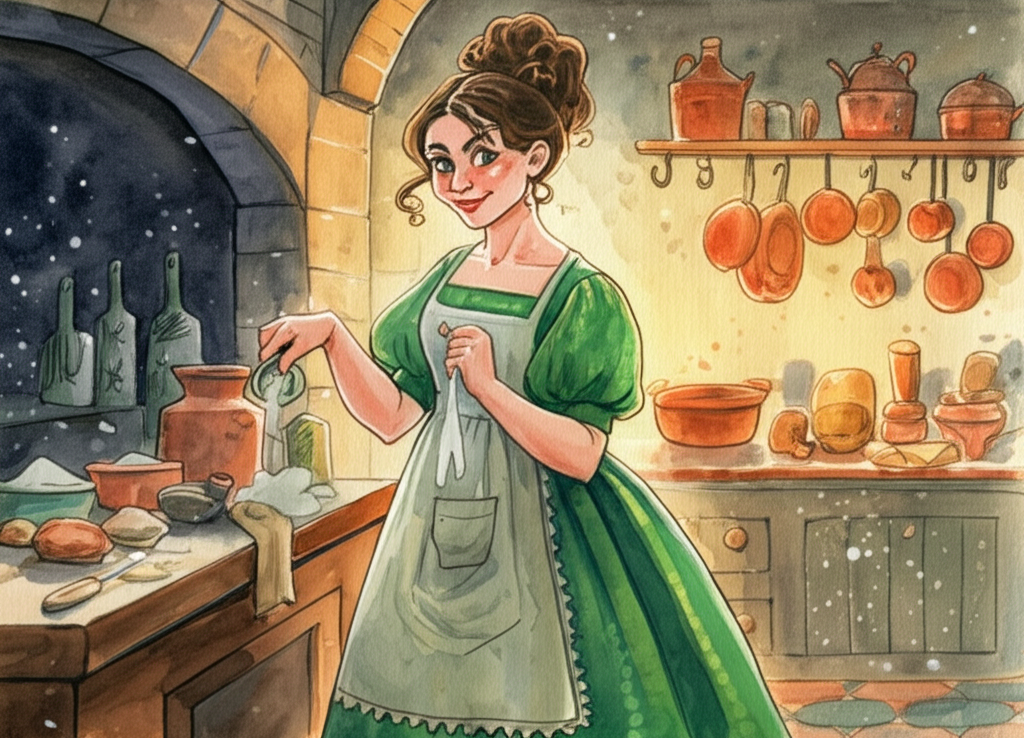
The prince’s friend put the treats aside and said, “Let’s talk, and I’ll eat them later.” So they sat and talked for a long time. Then the prince’s friend said, “Your princess made these for me?” “Yes,” said the prince. His friend was very smart, and he thought, “The princess doesn’t like me. I’m sure of it.” So he took some of the treats, broke them into pieces, and threw them to the crows. The crows flew down, and all the crows who ate the treats died right away! Then the prince’s friend threw a treat to a dog that was walking by. The dog ate it and fell down dead. This made the prince very angry. “I’ll never see my princess again!” he shouted. “She’s a terrible woman for trying to poison my friend—my friend who I love so much! If it wasn’t for him, I never would have married her!” He wouldn’t go back to his wife and stayed at the old woman’s house. His friend told him he should go back to his wife, but the prince wouldn’t. “No,” he said, “she’s a wicked woman! You never did anything bad to her, but she tried to poison you! I’ll never see her again!”
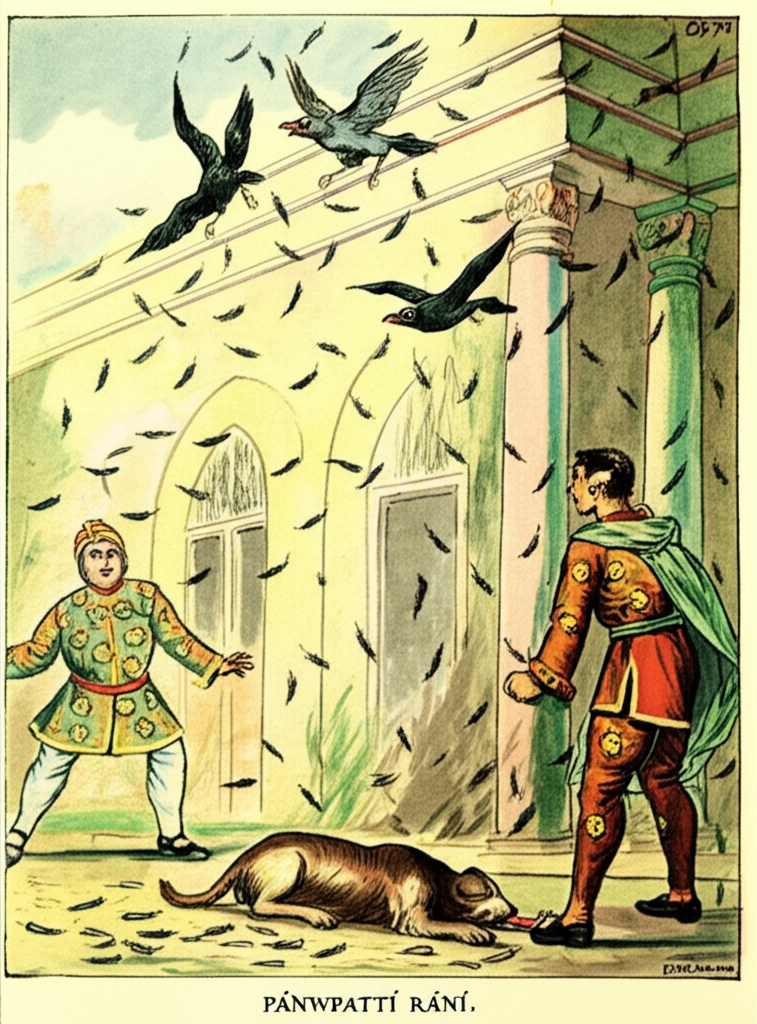
After a month, the prince’s friend said, “You really have to go back to Princess Foot Leaf. She’s your wife, and you have to go to her and take her back to your own country.” The prince still said he would never see her again. “If you want to see something that will make you happy,” said his friend, “go back to your wife for one day. Tonight, while she’s sleeping, take off all her jewelry, tie it up in a cloth, and bring it to me. But before you leave, poke her in the leg with this little pointy stick.” He gave him a small pointy stick made of iron.
The prince went back to the palace. His wife was very angry with him, but she didn’t show it. At night, while she was fast asleep, he took off all her jewelry, tied it up in a cloth, and poked her in the leg with the pointy stick. Then he ran back to his friend. The princess woke up and felt a bad pain and was all alone. She saw that her jewelry was gone. In the morning, she told her mom and dad that her jewelry had been stolen, but she didn’t say anything about the poke in her leg. The king called his helpers and told them a thief had come in the night and stolen his daughter’s jewelry. He sent them to look for the thief and catch him.
That morning, the prince’s friend got dressed up like a holy man. He made the prince put on normal clothes so nobody would know who he was. He sent him to the market to sell his wife’s jewelry. He told him what to say. The pretend holy man went to the river and sat down. The prince went through the market and tried to sell the jewelry. The king’s helpers caught him right away. “You thief!” they said. “Why did you steal the king’s daughter’s jewelry?” “I don’t know anything about the jewelry,” said the prince. “I’m not a thief. I didn’t steal it. The holy man, who is my teacher, gave it to me to sell in the market for him. If you want to know anything more about it, you have to ask him.” “Where is this holy man?” said the helpers. “He’s sitting by the river,” said the prince. “Let’s go to him. I’ll show you where he is.”
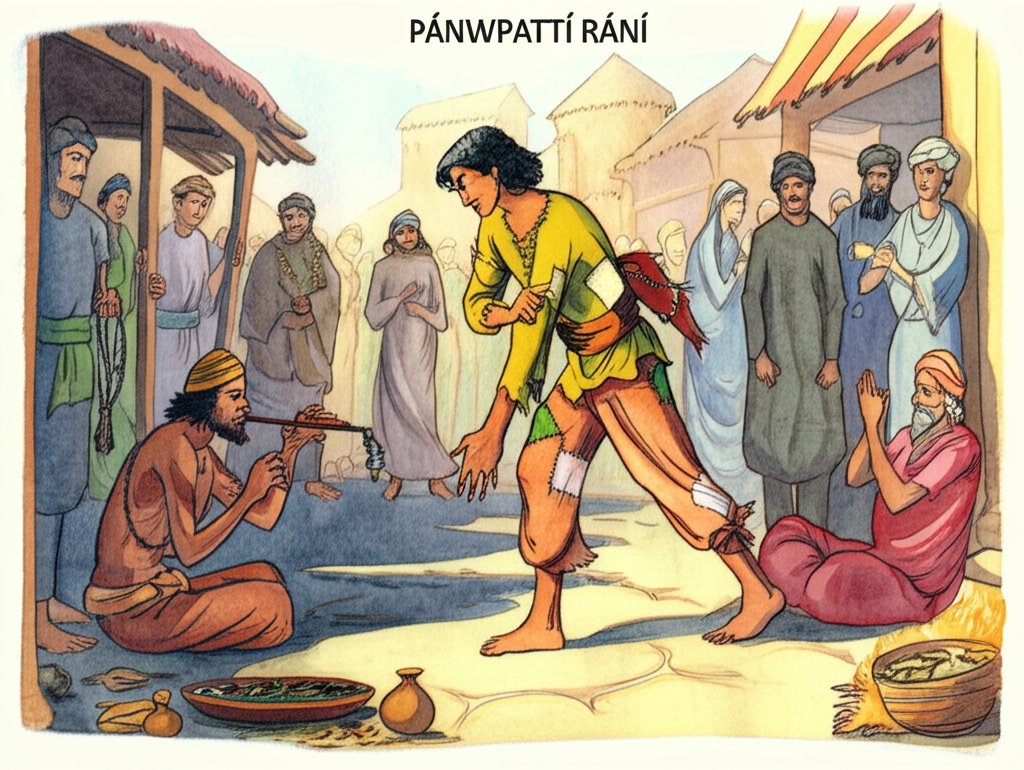
They all went down to the river, and there sat the holy man. “What’s going on here?” said the helpers to him. “Are you a holy man and a thief? Why did you steal the princess’s jewelry?” “Are those the princess’s jewels?” said the holy man. “I didn’t steal them. I didn’t know who they belonged to. Listen, and I’ll tell you what happened. Last night at twelve o’clock, I was sitting by this river when a woman came down to it—a woman I didn’t know. She took a dead body out of the river and started to eat it! This made me so angry that I took all her jewelry, and she ran away. I chased after her and poked her in the leg with my pointy stick. I don’t know if she was your king’s daughter or who she was, but whoever she is, she has the mark of the pointy stick in her leg.”
The helpers took the jewelry back to the palace and told the king everything the holy man had said. The king asked his wife if the princess had any hurt in her leg and told her the holy man’s story. The queen went to see her daughter and found her lying in bed and unable to get up because of the pain. When she looked at her leg, she saw the wound. She went back to the king and said, “Our daughter has the mark of the pointy stick in her leg!”
The king got very angry. He called his helpers and said, “Get a special chair and take my daughter to the jungle right now and leave her there! She’s a wicked woman who goes to the river at night to eat dead people! I don’t want her in my house anymore. Throw her out in the jungle!” The helpers did what they were told and left the princess, crying and sobbing in the jungle, partly from the pain in her leg and partly because she didn’t know where to go and had no food or water.
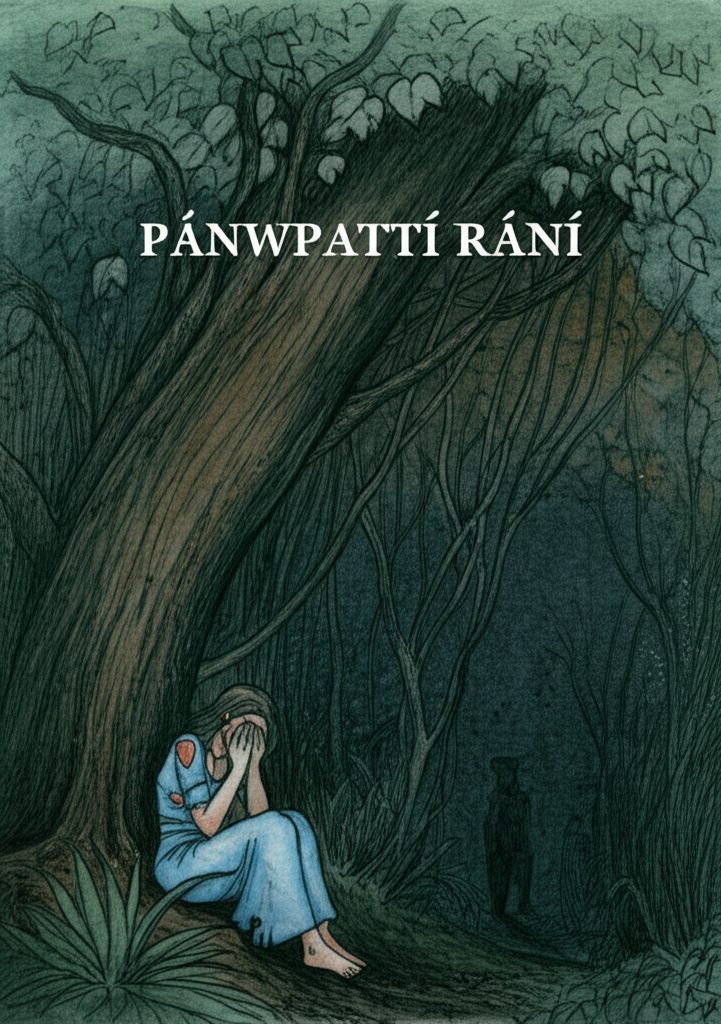
Meanwhile, her husband and his friend heard about her being sent into the jungle. So they went back to the old woman’s house and changed into their own clothes. Then they went to the jungle to find her. She was still crying, and her husband asked her why. She told him, and he said, “Why did you try to poison my friend? That was a terrible thing to do!” “Yes,” said the prince’s friend, “Why did you try to kill me? I never did anything wrong to you. I was the one who told your husband what you meant by touching the rose to your teeth, behind your ear, and at your feet. Without me, he never would have found you, never would have married you!” Then she knew who had caused all this trouble, and she was very sorry she had tried to kill her husband’s friend.
All three of them went home to her husband’s country. His mom and dad were very happy that their son had married a king’s daughter, and the king gave the prince’s friend a very big and fancy present!
The young king and his wife lived with his mom and dad, and they were always very happy together.